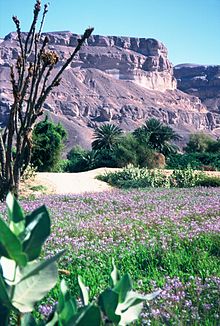Hadramaut
The Hadramaut region ( Arabic حضرموت, DMG Ḥaḍramaut ) is located in the east of the Republic of Yemen and is bordered in the south by the Gulf of Aden , in the east by Oman and in the north by the Rub al-Chali desert . In addition to the coastal plain, with al-Mukalla and ash-Schihr as the largest cities, the area also includes a desert-like plateau in the hinterland, which is cut through by a fertile, continuous valley system, the Wadi Hadramaut with its side valleys. In this valley, Seyun, Tarim and al-Qotn are the greatest places; Little Shibam is famous for its unique old town (world cultural heritage).
The region lives economically from the cultivation and export of tobacco , dates , wheat and coffee .
history
Since the 2nd millennium BC The Hadramaut was an important center of the South Arabian civilization. While there was extensive sea trade across the Indian Ocean from the coastal cities , the inland areas gained importance through the cultivation and trade of frankincense . This is where the incense route began , which led over Ma'rib and the Hejaz to Palestine . The main town of the ancient Hadramaut empire was Shabwa . The inhabitants of the Hadramaut were called Chatramotites , Chatramites or Adramites in ancient times .
Hadramaut corresponds to the biblical Hazarmawet , which is mentioned in the Bible ( Gen 10.26 EU and 1 Chr 1.20 EU ) as the son of Joktan .
In the 7th century the country was Islamized , in the 19th century it came under British rule with South Yemen . The Hadramaut has been united with the Republic of Yemen since 1990. Adolph von Wrede was the first European to travel to this area.
The Hadramitic Networks in the Indian Ocean
The inhabitants of the Hadramaut, the Hadramis, have a long trading tradition and are present as seafarers and traders throughout the Indian Ocean. Families with roots in the Hadramaut can be found in India , the Malay Archipelago and East Africa , from where they maintain lively contacts with their old homeland, often despite several centuries in the diaspora . An important means of maintaining these contacts is the annual pilgrimage to the tomb of the Prophet Hūd , which is little known outside of Hadramaut and the Hadramaut diaspora and which greatly contributes to the identity of the Hadramis around the world. The Tarīqa ʿAlawīya also plays an important role within the network of Hadramis .
In addition, the Hadramaut always represented an important center of scholarship for the Hadramis. In 1878/79 the ʿAlawī- Saiyid ʿAlī ibn Muhammad al-Hibschī (1843–1915) founded the mosque school ar-Riyād in Sai'ūn , which was attended by numerous Hadramis from all over the world World was visited. It served as a model for the school of the same name, which the scholar Habīb Sālih (1844–1935) founded in Lamu in 1901 , and for the Bā-Kathīr madrasa of ʿAbdallāh Bā Kathīr al-Kindī in Zanzibar City , which began operations in 1909.
See also
literature
- Ulrike Freitag : Hadhrami traders, scholars and statesmen in the Indian Ocean, 1750s - 1960s . Brill, Leiden, 1997.
- Ulrike Freitag: Sheikh or Sultan - Tribe or State? State formation in Hadramaut (Yemen) in the 19th and 20th centuries. In: Yearbook of the Historical College 2000, pp. 165–194 ( digitized version ).
- Friedhelm Hartwig: Hadramaut and the Indian Principality of Hyderabad: Hadramitic Sultanate Foundations and Migration in the 19th Century. Ergon, Würzburg, 2000.
- Marianus Hundhammer: Adoration of the prophets in the Hadramaut. The Ziyara according to Qabr Hud from a diachronic and synchronous perspective. Schwarz, Berlin, 2010. ISBN 978-3-87997-381-1 .
- Salma Samar Damluij: The Valley of Mudbrick Architecture: Shibam, Tarim & Wadi Hadramaut -Reading, 1992
Individual evidence
- ^ Heinrich Kiepert : Textbook of Ancient Geography. Berlin 1878, p. 188
- ↑ Lexicon for the Bible
- ↑ See Anne K. Bang: Sufis and scholars of the sea. Family networks in East Africa, 1860-1925 . Routledge Shorton, London and New York, 2003. pp. 144-148.
